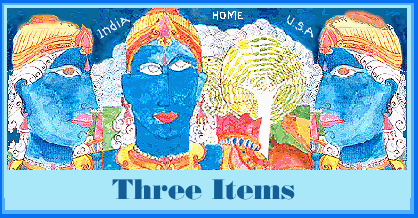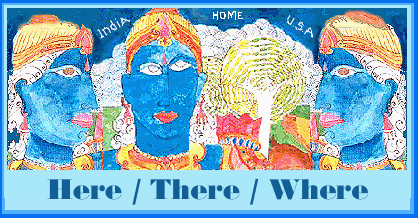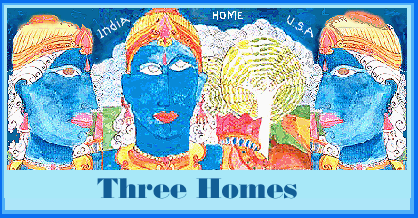… it is from those who have suffered the sentence of history–subjugation, domination, diaspora, displacement–that we learn our most enduring lessons.
Homi K. Bhabha, Redrawing the Boundaries

- Item 1 : A naturalized American citizen of Indian origin, I travel by American Airlines and Gulf Air via Dallas, Chicago, London, Abu Dhabi, and Bahrain. On my arrival at the Indira Gandhi International Airport in Delhi, the immigration officer matches the picture in my passport against my face to verify their identity (sameness), checks the information on the disembarkation card, and asks, ‘ Why have you come here?’ Although the information on the card is unambiguous -- ‘to visit family members and relatives’ -- he takes care to assure himself that there is no unwritten message in my eyes.

Terms of cultural engagement, whether antagonistic or affiliative, are produced performatively. The representation of difference must not be hastily read as the reflection of pre-given ethnic or cultural traits set in the fixed tablet of tradition. The social articulation of difference, from the minority perspective, is a complex, on-going negotiation that seeks to authorize cultural hybridities that emerge in moments of historical transformation. (2)
Diasporic identity formation serves as a primary and fundamental step in the larger transformation of history, though Lawrence Phillips, who traces Bhabha’s ‘third space’ philosophy to Derrida’s differance, finds fault with this dialectic description of history because it privileges the process of production rather than guarantee a product:
Bhabha seems to suggest that history is not made or lived as a temporal process in material space, but as the fluctuation of meaning that characterizes the signifier’s displacement along the chain of signification. This can be recognised as a temporal process, yet history, in this formulation, must be analogous to the deferral of absolute signification. Since the deferral is limitless, or at best circular, history itself can never signify absolutely; have any absolute meaning. (6)Such a schematic representation of history, Phillips argues, is untenable because it presents history as perpetual flux, its structures of difference leading to nothing beyond endless difference and deferral. But in The Nature and Context of Minority Discourse Abdul JanMohamed embraces such a position on history for that very same reason (1-16).
Any of the Christian races are welcome . . . [in California], or any of the white races. They all assimilate with Americans . . . and are gradually all fused together in one homogeneous mass. . . . Take a look at Chinamen in San Francisco. . . . They are for the most part an industrious people, forbearing and patient of injury, quiet and peaceable in their habits: say this and you have said all the good that can be said of them. They are uncivilized, unclean, filthy beyond all conception, without any of the higher domestic or social relations; lustful and sensual in their dispositions; every female is a prostitute, and of the basest order; the first words they learn are terms of obscenity or profanity, and beyond this they care to learn no more. Clannish in nature, they will not associate except with their own people . . . the Chinese quarter of the city is a by-word for filth and sin. Pagan in religion they know not the virtues of honesty, integrity or good faith; and in Court they never scruple to commit the most flagrant perjury. They have societies among themselves . . . by whose edict they are governed, and whom they dare not testify against for fear of secret death, thus rendering our very laws powerless. (4)
we are utterly opposed to any extensive emigration of Chinamen or other Asiatics to any part of the United States. . . . The security of free institutions is more important than the enlargement of its population. The maintenance of an elevated national character is of higher value than mere growth in physical power. . . . With Oriental thoughts will necessarily come Oriental social habits. . . . The free institutions and Christian virtues of America have a sufficiency of adverse elements to contend with already. We have four millions of degraded negroes in the South . . . and if, in addition . . . there were to be a flood-tide of Chinese population -- population befouled with all the social vices . . . with heathenish souls and heathenish propensities, whose character, and habits, and modes of thought are firmly fixed by the consolidating influence of ages upon ages . . . we should be prepared to bid farewell to republicanism and democracy. (1)In the case of the thousands of Vietnamese ‘boat people’ who came to the United States as political refugees, the experience was different from that of either the Indian or the Chinese, complicated as it was by the American military engagement in Vietnam, the inglorious defeat, and the subsequent moral compunction of a nation haunted by its ethical lapse masquerading as national interest. The diasporic experiences for the Mexican Americans, the Cuban Americans, the Eastern Europeans, the Africans -- each is different. The African diasporic experience in America is especially poignant because of the Africans’ experience with the institution of slavery and the subsequent segregation politics. As Zora Neale Hurston has said, "Slavery is the price I paid for civilization, and the choice was not with me. It is a bully adventure and worth all that I have paid through my ancestors for it"(375-76).


The alternatives for the underdeveloped countries, whose political development will be decisive for the next hundred years, are not capitalism and socialism, but totalitarian socialism and Marxist humanist socialism. . . . The West has much to offer as a leader of such a development for the former colonial nations; not only capital and technical advice, but also the Western humanist tradition of which Marxist socialism is the upshot; the tradition of man’s freedom, not only from, but his freedom to -- to develop his own human potentialities, the tradition of human dignity and brotherhood. (viii)Though Fromm’s rhetorical strategy is designed to package Marx for the consumption of the capitalist Western readers, in retrospection his neo-colonial position belies the historical record of colonialism in the nineteenth and the twentieth centuries.
as the industrial revolution increased production efficiency, urban areas received the influx of a large percentage of agricultural labor, creating a pool of surplus population. These potentially rebellious unemployed and displaced workers needed to be depressurized in the marginal areas of the labor market. Toward that end, the organizers of colonialism had to persuade their recruits and foot soldiers about the profitability as well as the nobility of their mission. (82)These ‘recruits’ had to believe that the country they were working for was superior to the colonies where they worked, that they themselves were superior to the people in these colonies because of their role in the material production system, that they earned their compensation -- including the luxurious lifestyle, the pecuniary benefits, and the exercise of power and privilege. Their exploitation and plunder were, in essence, highlighted as charity and benevolence. The fact that they might be the bottom of the totem pole in the class structure back home was easy to forget in the state of amnesia caused by both distance from home and by the presumption of their new role as the missionaries of progress and civilization. The blind spot in the whole scene is the heart of their own darkness; the language of humanism merely plasters the surface of there (the colonized) with the interests of here (the colonizer).
It can be argued that the difficulty of handling increasing levels of cultural complexity, and the doubts and anxieties they often engender, are reasons why ‘localism,’ or the desire to return home, becomes an important theme -- regardless of whether the home is real or imaginary, temporary, syncretized, or simulated, or whether it is manifest in a fascination with the sense of belonging, affiliation, and community attributed to the homes of others. (47)
There are tendencies [in global capitalism] going in opposite directions. On the one hand, there is a tendency toward this international centralization of power. There is also an opposite tendency. All around the world, there is much more involvement in grass-roots organizations, there is regionalism [and moves toward developing] more local autonomy. (qtd. in Rob Wilson and Wimal Dissanayake 1)One might see the traces of such localism in the rise of fundamentalism around the world, as well as in the rise of small splinter groups barricading themselves against the center in trenches along the border. On a more benign scale but in a more radically political level, the clamor for localism manifests in school boards, in county commissions, and sometimes even in colleges and universities whose traditional modus operandi is threatened by challenges from ‘outsiders.’ The second, more important and far more significant, answer is that the peripheral dissipation inevitably reduces the diametric expansion of one’s territory (or empire). Hence, the loud echo of a local Muslim plight in Croatia or of the domestic economic crisis in Indonesia is heard in the political and fiscal fortresses of the world. The globalization of the local has localized the whole globe.

- Home as Place: Home is where I began, and where I shall return. In "The Narrative Production of 'Home,' Community, and Political Identity in Asian American Theater," Dorinne Kondo paraphrases Gayatri Spivak in defining home for people on the margins as ‘that which we cannot not want.’ "It stands for a safe place, where there is no need to explain oneself to outsiders; it stands for community" (97).
The logic underlying institutional policies of nativism is complex. Derived from the Latin nasci (to be born), the word nation provides a starting point as it encompasses the domicile family condition of belonging, the ‘natio’ signifying the local community, and a political nation-state. But as Biddy Martin and Chandra Talpade Mohanty suggest, ‘community’ as the product of work, of struggle "is inherently unstable, contextual; it has to be constantly reevaluated in relation to critical political priorities; and it is the product of interpretation, interpretation based on an attention to history." Similarly, Raymond Williams has noted that although "'Nation' as a term is radically connected with 'native,' we are born into relationships which are typically settled in place," and the jump from that primary and ‘placeable’ bonding to anything like the modern nation-state is entirely artificial. Yet, place as a reservoir of collective memories provides instruments of nativism and sameness (identity). These memories are collected in the books, newspapers, and other printed texts, which contribute to the formation of the ‘imaginary community’ that Benedict Anderson outlines.
In Tenement Lover Jessica Hagedorn, a Philipina American musician, performer, and writer, says: "When I think of home now I mean three places. San Francisco Bay area really colored my work. New York is where I live. But Manila will always have a hold on me. I really don’t think of myself as a citizen of one country but as a citizen of the world" (100). Similarly Naim Araidi says in an interview with Smadar Lavie, "I don’t feel grounded anywhere. I have come back to the village, but it feels like a hotel, not home" (55). Similarly, I ask "Where then is my home?" I struggle daily in the town called Shreveport in the bible-belt south of the United States: I teach there; I live there; I write about people who live there. It is my present. But my mind has been shaped by four other places -- Cuttack, Bhubaneswar, New Orleans, and College Station -- each of which can lay its claim as the home base of my psyche, hence my home. Above all, however, it is Balugaon, that clammy, dingy, fish-smelling sultry town on Chilika Lake where I sometimes return when I sing or dream of home. Does my naturalized American citizenship dissolve the past and make me a tabula rasa? Can one be reborn out of nothing, out of a void?
- Home as Time: As a function of history, home is the reservoir of public myths and private memories. Mike Featherstone has noted two key features of postmodernism: first, "it entails a loss of confidence in the master narratives of progress and enlightenment," a Western paradigm, and a subsequent recognition of contingency, incoherence, and ambivalence; and second, "a democratization and popularization of forms of knowledge and cultural production and dissemination" (50) which were previously the monopoly of established groups. These, he deduces, are forces that have led to a dehistorized history and replaced it with histories.
To review my postcolonial self, then I must return to the past or to a crossroads of history. Born sometime around the mid-twentieth-century after the Indian national independence, after the declaration of the republic status of the country, I can embrace my postcolonial identity as an Indian. In addition, my early education and training in the indigenous cultural texts, such as the Bhagabata, the Puranas, the Gita -- much of it recited to me at four in the dew-damp mornings in the harvest seasons supposedly to please the gods but more practically, perhaps, to ward off early morning theft from the barn next door -- all make my experience authentic and real. There was little or nothing imagined about my ‘imaginary community’ ; the soil, the sand, the cow dung all were real. The text was as much in the book as it was on the stone steps of the village pond, where a vermilion covered rectangular stone claimed its divine status as a goddess and received morning and evening worshippers. The text was there on the mud walls where the most complex mythic images were meticulously drawn in circles and triangles with jhoti (pureed rice), where gods smiled in their cosmic glee.
But these early essences were coated soon with English poems such as "The boy stood on the burning deck whence all but he had fled" ("Casabianca"), or "There dwelt a miller hale and bold beside the river Dee;/ He worked and sang from morn to night, no lark was blither than he"("Miller of the Dee"); or "Breathes there the man with soul so dead, who to himself hath never said, this is my own, my native land? If such there breathes, go mark him well,/ For him no minstrel song shall swell"; or "Inchcape Rock" or "Ballad of Father Gilligan" or "Abu Ben Adhem." These were poems alien to my experience; they did not speak to my history, nor to my dreams, my future. They were my colonial inheritance, the cocoon that covered up my postcolonial self. They scarred my consciousness indelibly to the point that I still remember those lines. True, these readings were later punctuated with unforgettable lines from Gangadhar Meher and Radhanath Ray, Upendra Bhanja and Kabisurya Baladev, or Godavarish Mishra and Godavarish Mahapatra, and passages from Gopinath Mohanty and Kanhu Charan Mohanty and Fakir Mohan Senapati and Rabindranath Tagore, but the colonial virus turned active later and showed up in my critical veneration for Eliot and his ‘objective correlative.’ I read more Milton than Sarala Das, and dissected with the Derridean and de Manian deconstructive scalpel Oriya poetry by Sitakant Mahapatra, Ramakant Rath, Soubhagya Misra and Jayanta Mohapatra.
- Virtual Home/ Virtual History: I began this presentation with a reference to Trishanku, a king in the Hindu epic The Ramayana. In his obsession with going to the heaven with his own body, Trishanku represents the consequences of narcissism; his story includes an encounter between the divine and the human, and the creation of an intermediate virtual space between earth and heaven, but above all it highlights the dichotomy between the body and the spirit. The sage Viswamitra enables King Trishanku to ascend to heaven in/with his own body, but Indra, the king of gods, returns him back to earth to protect the integrity of the gods’ land. As the king falls headlong down through the ethereal space, Viswamitra freezes him and builds a virtual heaven with its own pantheon of gods and angels. The sage is later pacified by a repentant Indra, but Trishanku remains in his third space. Indeed, he is that third space.